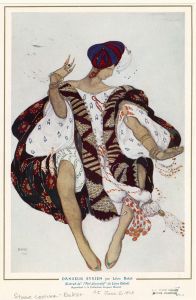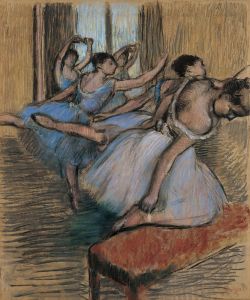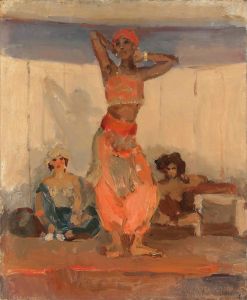
Danseuse saluant
A hand-painted replica of Edgar Degas’s masterpiece Danseuse saluant, meticulously crafted by professional artists to capture the true essence of the original. Each piece is created with museum-quality canvas and rare mineral pigments, carefully painted by experienced artists with delicate brushstrokes and rich, layered colors to perfectly recreate the texture of the original artwork. Unlike machine-printed reproductions, this hand-painted version brings the painting to life, infused with the artist’s emotions and skill in every stroke. Whether for personal collection or home decoration, it instantly elevates the artistic atmosphere of any space.
Edgar Degas's Danseuse saluant (translated as Dancer Bowing or Dancer Greeting) is a pastel artwork created by the French Impressionist artist, renowned for his depictions of ballet dancers. Degas, who lived from 1834 to 1917, is celebrated for his innovative use of pastel and his ability to capture movement, light, and the human form with remarkable precision. This particular work is one of many in his extensive series of ballet-themed pieces, which became a central focus of his artistic career.
Danseuse saluant portrays a ballerina in a moment of poised elegance, caught mid-bow as she acknowledges the audience. The dancer is depicted wearing a tutu, a hallmark of Degas's ballet works, and the composition emphasizes her graceful posture and the flowing lines of her form. Degas's mastery of pastel is evident in the delicate rendering of textures, from the soft folds of the tutu to the subtle play of light on the dancer's skin. The background is typically abstract, a characteristic feature of Degas's later works, which often focused on the figure while leaving the setting less defined.
Degas's fascination with ballet dancers was rooted in his interest in capturing the human body in motion and exploring the interplay of effort and grace. His works often depict dancers both on stage and in rehearsal, offering a behind-the-scenes glimpse into the world of ballet. Danseuse saluant is no exception, showcasing the artist's ability to convey the physicality and discipline of dance alongside its beauty.
The exact date of creation for Danseuse saluant is not definitively documented, but it is believed to have been produced in the late 19th century, during the height of Degas's engagement with pastel as a medium. By this time, Degas had largely transitioned away from oil painting, favoring pastels for their immediacy and vibrant color. This shift allowed him to experiment with layering and blending techniques, which are evident in the rich textures and dynamic composition of this work.
Today, Danseuse saluant is recognized as a quintessential example of Degas's ballet-themed art. It reflects his deep understanding of anatomy, his innovative approach to composition, and his ability to capture fleeting moments with a sense of timelessness. The piece is housed in a private collection, and like many of Degas's works, it continues to be celebrated for its contribution to the Impressionist movement and its enduring influence on modern art.


















